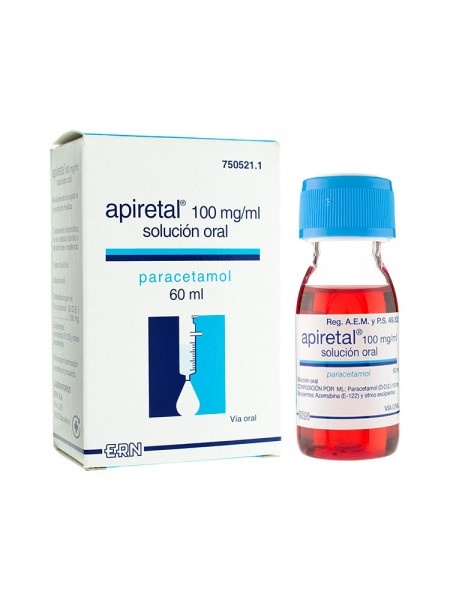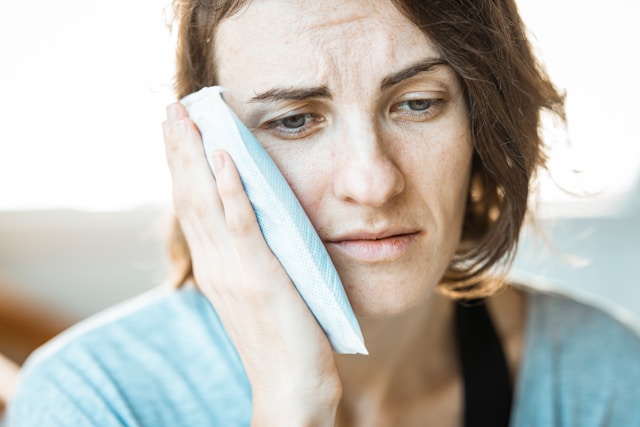

APIREDOL 100 mg/ml ORAL SOLUTION

Ask a doctor about a prescription for APIREDOL 100 mg/ml ORAL SOLUTION

How to use APIREDOL 100 mg/ml ORAL SOLUTION
Introduction
Package Leaflet: Information for the User
Apiredol 100 mg/ml Oral Solution
Paracetamol
Read this package leaflet carefully before starting to take this medicine, as it contains important information for you.
Follow the administration instructions of the medicine contained in this package leaflet or as indicated by your doctor, pharmacist, or nurse.
- Keep this package leaflet, as you may need to read it again.
- If you need advice or more information, consult your pharmacist.
- If you experience side effects, consult your doctor, pharmacist, or nurse, even if they are not listed in this package leaflet. See section 4.
If your symptoms worsen or if the fever persists for more than 3 days or the pain for more than 3 days in children or 5 days in adults (2 days for throat pain), you should consult a doctor.
- You should consult a doctor if you do not feel better or if you feel worse, or if the fever persists for more than three days or the pain lasts for more than 3 days in children or 5 days in adults (2 days for throat pain).
Contents of the Package Leaflet
- What is Apiredol and what is it used for
- What you need to know before taking Apiredol
- How to take Apiredol
- Possible side effects
- Storage of Apiredol
- Package contents and additional information
1. What is Apiredol and what is it used for
Apiredol 100 mg/ml oral solution belongs to a group of medicines called analgesics and antipyretics.
This medicine is indicated for febrile states with a duration of less than 3 days and for the relief of mild or moderate pain.
You should consult a doctor if you do not feel better or if you feel worse, or if the fever persists for more than three days or the pain lasts for more than 3 days in children or 5 days in adults (2 days for throat pain).
2. What you need to know before taking Apiredol
Do not take Apiredol
- If you/your child is allergic to paracetamol or any of the other components of Apiredol (listed in section 6).
Warnings and precautions
- Consult your doctor, pharmacist, or nurse before starting to take Apiredol.
- Consult your doctor before giving this medicine to children under 3 years of age.
- Do not exceed the recommended dose in section 3
- In patients with kidney, heart, or lung disease, and in patients with anemia (decrease in hemoglobin in the blood, due to or not due to a decrease in red blood cells), or with low levels of a blood enzyme called glucose-6-phosphate dehydrogenase, consult your doctor before taking the medicine.
- If you have liver problems (including Gilbert's syndrome), consult your doctor, as you may need a dose reduction and/or an increase in the interval between doses.
- In patients with a weight of less than 50 kg due to anorexia, malnutrition, or dehydration, as this may increase liver toxicity.
- Consumption of alcoholic beverages may cause paracetamol to produce liver damage.
- In case of high fever (>39°C), ask your doctor before using Apiredol.
- If the pain persists for more than 3 days in children or 5 days in adults (2 days for throat pain) or the fever for more than 3 days, or worsens or other symptoms appear, treatment should be discontinued and a doctor consulted.
- During treatment with Apiredol, immediately inform your doctor if you have serious diseases, such as severe renal failure or sepsis (when bacteria and their toxins circulate in the blood, causing damage to organs), or if you suffer from malnutrition, chronic alcoholism, or if you are also taking flucloxacillin (an antibiotic). A serious disease called metabolic acidosis (an anomaly in the blood and fluids) has been reported in patients in these situations when paracetamol is used at regular doses for a prolonged period or when paracetamol is taken with flucloxacillin. The symptoms of metabolic acidosis may include: severe breathing difficulties with deep and rapid breathing, drowsiness, feeling of discomfort (nausea) and vomiting.
Using Apiredol with other medicines
Consult your doctor or pharmacist if you/your child is using, has recently used, or may need to use any other medicine.
In particular, if you/your child is using medicines that contain any of the following active ingredients, as it may be necessary to modify the dose or discontinue treatment of any of them:
- Antibiotics (chloramphenicol, flucloxacillin). In the case of flucloxacillin, due to a serious risk of blood and fluid anomaly (called metabolic acidosis) that requires urgent treatment (see section 2).
- Oral anticoagulants (acenocoumarol, warfarin)
- Oral contraceptives and estrogen treatments
- Antiepileptics (lamotrigine, phenytoin, or other hydantoins, phenobarbital, methylphenobarbital, primidone, carbamazepine)
- Antituberculars (isoniazid, rifampicin)
- Barbiturates (used as sleep inducers, sedatives, and anticonvulsants)
- Activated charcoal, used for diarrhea or gas treatment
- Colestyramine (used to decrease blood cholesterol levels)
- Medicines used to treat gout (probenecid and sulfinpyrazone)
- Medicines used to relieve stomach, intestine, and bladder spasms or cramps (anticholinergics)
- Metoclopramide and domperidone (used to prevent nausea and vomiting)
- Propranolol used in the treatment of high blood pressure (hypertension) and heart rhythm disorders (cardiac arrhythmias)
- Zidovudine (used in the treatment of patients infected with the human immunodeficiency virus, the cause of AIDS).
Interference with laboratory tests
If you/your child is going to undergo any laboratory tests (including blood tests, urine tests, skin tests using allergens, etc.), inform your doctor that you/your child is taking this medicine, as it may alter the results of these tests.
Taking Apiredol with food, drinks, and alcohol
Apiredol can be diluted with water, milk, or fruit juice. The use of paracetamol in patients who habitually consume alcohol (three or more alcoholic beverages per day) may damage the liver.
Pregnancy, breastfeeding, and fertility
Consult your doctor or pharmacist before using any medicine.
In case of necessity, Apiredol can be used during pregnancy. You should use the lowest possible dose that reduces pain or fever and use it for the shortest possible time. Contact your doctor if the pain or fever does not decrease or if you need to take the medicine more frequently.
Therapeutic doses of paracetamol can be used during pregnancy and breastfeeding.
Driving and using machines
No effects have been described that modify the ability to drive and use machines.
Apiredol contains azorubine and sodium (from sodium saccharin)
This medicine may produce allergic reactions.
This medicine contains less than 1 mmol of sodium (23 mg) per ml; i.e., it is essentially "sodium-free".
3. How to take Apiredol
Follow the administration instructions of the medicine contained in this package leaflet or as indicated by your doctor, pharmacist, or nurse. In case of doubt, consult your doctor, pharmacist, or nurse.
Apiredol is reserved for children with a weight of up to 32 kg (approximately from 0 months to 10 years). It is necessary to respect the dosage defined based on the child's body weight and therefore select the appropriate dose of the oral solution in ml.
The approximate ages based on body weight are provided for informational purposes only.
The recommended daily dose of paracetamol is approximately 60 mg/kg/day, divided into 4 or 6 daily administrations, i.e., 15 mg/kg every 6 hours, or 10 mg/kg every 4 hours.
In children under 3 years, it is recommended to dose the oral solution in drops (4 mg/drop), with the drop counter cap (1) included in the 30 ml package.
In children 3 years or older, it is recommended to dose the oral solution in milliliters (ml) (100 mg/ml) using the oral syringe (2) included in the 60 ml package.
For administration of 15 mg/kg every 6 hours, the schedule is as follows:

Child's weight | Age (approximate) | Volume in ml | Paracetamol mg | Equivalent in drops |
Up to 4 kg | from 0 to 3 months | 0.6 ml | 60 mg | 15 drops |
Up to 7 kg | from 4 to 8 months | 1.0 ml | 100 mg | 25 drops |
Up to 8 kg | from 9 to 11 months | 1.2 ml | 120 mg | 30 drops |
Up to 10.5 kg | from 12 to 23 months | 1.6 ml | 160 mg | 40 drops |
Up to 13 kg | from 2 to 3 years | 2.0 ml | 200 mg | -- |
Up to 18.5 kg | from 4 to 5 years | 2.8 ml | 280 mg | -- |
Up to 24 kg | from 6 to 8 years | 3.6 ml | 360 mg | -- |
Up to 32 kg | from 9 to 10 years | 4.8 ml | 480 mg |
For a direct calculation, you can also multiply the child's weight in kg by 0.15; the result is the ml of Apiredol to be administered.
In children, these doses should be administered every 6 hours, including at night.
If after 3-4 hours of administration the desired effects are not obtained, the dose can be advanced every 4 hours, in which case 10 mg/kg will be administered.
For children with a weight of less than 7 kg (6 months), the use of suppositories should be considered, if available, except in cases where administration in this form is not possible for clinical reasons (e.g., diarrhea).
Never exceed the maximum daily dose of 60 mg/kg/day without medical recommendation.
Patients with liver or kidney disease, see section 2, Warnings and precautions.
Administration of the preparation is subject to the appearance of painful or febrile symptoms. As these symptoms disappear, this medication should be discontinued.
Instructions for the correct administration of the preparation
Apiredol is administered orally.
30 ml bottle with safety drop counter cap (2 ml):

1 and 2.- Hold the bottle firmly with one hand. With the other, take the cap between the thumb and index fingers on the two triangles indicated on the cap with the word “PRESS”.
3.- To open, press on the two triangles and unscrew the cap by turning it to the left (counterclockwise). Remove the necessary amount with the help of the drop counter cap. Administer directly or dilute the drops with water.
4.- To close, turn the cap to the right (clockwise) until you hear a “click”.
Close the bottle well after each administration.
60 ml bottle with safety screw cap, plus oral syringe (5 ml):
1.- Open the bottle by following the instructions on the cap (on the first opening, the seal will break).
2.- Insert the oral syringe, pressing into the perforated hole in the cap.
3.- Invert the bottle and remove the necessary dose.
4.- Administer directly or dilute with water, milk, or fruit juice.
5.- The oral syringe should be washed with water after each intake.
Close the bottle well after each administration.
If you take more Apiredol than you should
If you/your child has taken more paracetamol than you/your child should, consult your doctor or pharmacist immediately or call the Toxicology Information Service, phone 91 562 04 20, indicating the medicine and the amount used. It is recommended to take the package and package leaflet of the medicine to the healthcare professional.
If you have ingested an overdose, you/your child should go quickly to a medical center, even if there are no symptoms, since they often do not manifest until 3 days after ingestion of the overdose, even in cases of severe poisoning. The symptoms of overdose may be: dizziness, vomiting, loss of appetite, yellowing of the skin and eyes (jaundice), and abdominal pain.
Paracetamol overdose is considered to be the ingestion of a single dose of more than 6 g in adults and more than 100 mg/kg of body weight in children. Treatment of the overdose is more effective if started within 4 hours of ingestion of the medicine.
In case the patient is being treated with barbiturates or suffers from chronic alcoholism, they may be more susceptible to a paracetamol overdose.
In general, symptomatic treatment will be performed.
If you forget to take Apiredol
Do not take a double dose to make up for forgotten doses.
In case you/your child has forgotten a dose, take another as soon as possible and continue with the usual schedule. However, if the time of the next intake is very close, skip the forgotten dose and take the next dose at the usual time.
If you interrupt treatment with Apiredol
If you have any other doubts about the use of this medicine, ask your doctor, pharmacist, or nurse.
4. Possible side effects
Like all medicines, this medicine can cause side effects, although not everyone gets them.
Paracetamol side effects are, in general, rare (affect between 1 and 10 patients out of 10,000) or very rare (affect less than 1 patient out of 10,000).
Rare side effects are discomfort, hypotension, and increased liver enzyme levels.
Very rarely, it can damage the liver at high doses or prolonged treatments. Also, very rarely, hypoglycemia, cloudy urine, renal side effects, skin rashes, urticaria, anaphylactic shock, and blood alterations such as neutropenia or leucopenia may appear.
Very rare cases of serious skin reactions have been reported.
Frequency not known (cannot be estimated from the available data): A serious disease that can make the blood more acidic (called metabolic acidosis) in patients with severe disease who use paracetamol (see section 2).
Reporting of side effects
If you experience any type of side effect, consult your doctor, pharmacist, or nurse, even if it is a possible side effect that does not appear in this package leaflet. You can also report them directly through the Spanish Pharmacovigilance System for Human Use Medicines: https://www.notificaram.es. By reporting side effects, you can contribute to providing more information on the safety of this medicine.
5. Storage of Apiredol
Keep this medicine out of the sight and reach of children.
Do not use this medicine after the expiration date that appears on the package after CAD. The expiration date is the last day of the month indicated.
Keep the bottle in the outer packaging. It does not require any special storage temperature.
After the first opening, keep the bottle in the outer packaging.
Once the bottle is opened, the contents must be used within a maximum period of 6 months.
Medicines should not be disposed of through wastewater or household waste. Deposit the packages and medicines that you no longer need in the SIGRE Point of the pharmacy. In case of doubt, ask your pharmacist how to dispose of the packages and medicines that you no longer need. This way, you will help protect the environment.
6. Container Content and Additional Information
Composition of Apiredol
- The active ingredient is paracetamol. Each ml of solution contains 100 mg of paracetamol.
- The other components (excipients) are: Macrogol 600, glycerol, raspberry essence, sodium saccharin (E-954), azorubine (carmoisine) (E-122), and purified water.
Appearance of Apiredol and Container Content
Apiredol is presented in the form of a transparent red oral solution, packaged in a 30 or 60 ml plastic bottle.
- 30 ml Container:transparent plastic bottle with a 2 ml child-resistant safety dropper cap.
- 60 ml Container:transparent plastic bottle with a child-resistant safety closure and a 5 ml oral syringe.
Marketing Authorization Holder and Manufacturer
Marketing Authorization Holder
IONFARMA, S.L.U.
Perú, 228
08020 Barcelona
Spain
Tel.: +34 93 314 80 11 Fax.: +34 93 314 40 96
Manufacturer
LABORATORIOS ERN, S.A.
Gorgs Lladó, 188
08210 Barberá del Vallés, Barcelona
Spain
This medicinal product is authorized in the Member States of the European Economic Area under the following names:
Spain Apiredol 100 mg/ml oral solution
Germany Apiredol 100 mg/ml solution for ingestion
France Dolstic 100 mg/ml drinkable solution
Dolstic 100 mg/ml drinkable solution in drops
Italy Apiredol 100 mg/ml oral solution
Poland Pedicetamol
Portugal Apiredol 100 mg/ml Oral Solution
Date of the last revision of this leaflet: February 2025
Other Sources of Information
Detailed and updated information on this medicinal product is available on the website of the Spanish Agency for Medicines and Health Products (AEMPS) http://www.aemps.gob.es/

How much does APIREDOL 100 mg/ml ORAL SOLUTION cost in Spain ( 2025)?
The average price of APIREDOL 100 mg/ml ORAL SOLUTION in November, 2025 is around 1.75 EUR. Prices may vary depending on the region, pharmacy, and whether a prescription is required. Always check with a local pharmacy or online source for the most accurate information.
- Country of registration
- Average pharmacy price1.75 EUR
- Active substance
- Prescription requiredNo
- Manufacturer
- This information is for reference only and does not constitute medical advice. Always consult a licensed doctor before taking any medication. Oladoctor is not responsible for medical decisions based on this content.
- Alternatives to APIREDOL 100 mg/ml ORAL SOLUTIONDosage form: TABLET, 1 gActive substance: paracetamolManufacturer: Uxa Farma S.A.Prescription requiredDosage form: TABLET, 1 gActive substance: paracetamolManufacturer: Laboratorios Cinfa S.A.Prescription not requiredDosage form: TABLET, 1 gActive substance: paracetamolManufacturer: Laboratorios Cinfa S.A.Prescription not required
Alternatives to APIREDOL 100 mg/ml ORAL SOLUTION in other countries
The best alternatives with the same active ingredient and therapeutic effect.
Alternative to APIREDOL 100 mg/ml ORAL SOLUTION in Poland
Alternative to APIREDOL 100 mg/ml ORAL SOLUTION in Ukraine
Online doctors for APIREDOL 100 mg/ml ORAL SOLUTION
Discuss dosage, side effects, interactions, contraindications, and prescription renewal for APIREDOL 100 mg/ml ORAL SOLUTION – subject to medical assessment and local rules.















